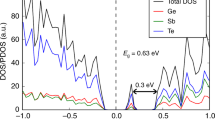Abstract
Electronic switching in amorphous chalcogenide semiconductors has been observed and studied for nearly forty years. Technological exploitation of this phenomenon has most recently emerged in DVD’s where GST, a compound of germanium, antimony, and tellurium, is used to store information. We explain how GST behaves as a switch and how X-ray absorption fine structure can be used to unlock the specifics of the switching process. The tool that leads to this deeper understanding is the bond constraint theory. We explain how this theory leads to an explanation of switching and of the behavior and properties of amorphous materials in general. Finally, the prospects for developing GST-related materials into non-volatile memory media that could be the basis for glass computers are discussed.
Similar content being viewed by others
References
S R Ovshinsky, Phys. Rev. Lett. 21, 1450 (1968)
N Yamada, E Ohno, K Nishiuchi and N Akahira, J. Appl. Phys. 69, 2849 (1991)
T Nonaka, G Ohbayashi, Y Toriumi, Y Mori and H Hashimoto, Thin Solid Films 370, 258 (2000)
B Lee, J R Abelson, S G Bishop, D Kang, B Cheong and K Kim, J. Appl. Phys. 97, 093509 (2005)
D A Baker, S C Agarwal, G Lucovsky, M A Paesler and P C Taylor, MRS Proc. (Spring Meeting, San Francisco, April 2006), Invited paper
D A Baker, M A Paesler, G Lucovsky, S C Agarwal and P C Taylor, Phys. Rev. Lett. 96, 255501 (2006)
M F Thorpe, D J Jacobs, M V Chubynsky and J C Phillips, J. Non-Cryst. Solids 266–269, 859 (2000)
F A Cotton and G Wilkinson, Advanced inorganic chemistry, 3rd Edition (Interscience Publishers, New York, 1972), Chap. 3, p. 117 (Table 3.4)
J C Phillips, J. Non-Cryst. Solids 34, 153 (1979)
J L LaGrange, Mécanique Analytique (Paris, 1788)
J C Maxwell, Philos. Mag. 27, 294 (1864)
M F Thorpe, J. Non-Cryst. Solids 57, 355 (1983)
D J Jacobs and M F Thorpe, Phys. Rev. Lett. 75, 22 (1995)
X Feng, W J Bresser and P Boolchand, Phys. Rev. Lett. 78, 23 (1997)
Author information
Authors and Affiliations
Corresponding author
Rights and permissions
About this article
Cite this article
Agarwal, S.C., Paesler, M.A., Baker, D.A. et al. Bond constraint theory and the quest for the glass computer. Pramana - J Phys 70, 245–254 (2008). https://doi.org/10.1007/s12043-008-0043-y
Published:
Issue Date:
DOI: https://doi.org/10.1007/s12043-008-0043-y




